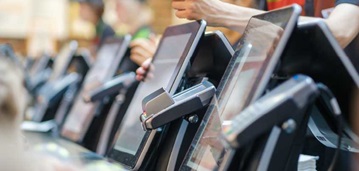Bits, Bytes and Bites: How Technology is Innovating the Bar/Restaurant Industry

The dining experience has always been about socializing—although these days, socializing often means posting pictures of gorgeous plates of food on social media sites. Technology has added another type of "byte" to eating out, with more people willingly heads-down interacting via their mobile devices while eating.
Diners and bar patrons these days expect to have access to Wi-Fi wherever they are, to be able to send out social media photos and messages as well as surf the Internet while they’re waiting for their order or even during their dining or drinking experience. These days, it’s not uncommon to see entire tables of patrons in a restaurant spending more time looking at their mobile devices than interacting with each other.
This new reality is having a profound impact on the bar and restaurant industry across all categories—from fast dining at quick service restaurant chains to casual and upscale dining at more traditional sit-down eateries. Wi-Fi service, once relegated to coffee houses and other establishments catering to the work-and-sip crowd, is now expected in every facility, from the corner bar to the most upscale restaurant. What’s more, a new breed of wireless point-of-sale technologies is enabling patrons to order and pay right from their table, freeing wait staff to provide other forms of personalized service.
To serve up the connectivity and features—and effectively run the back-office operations that enable these services—bars and restaurants must have the right connectivity portfolio that provides robust bandwidth to meet the wants of customers and the needs of the establishment.
A Healthy Serving of Wireless
It’s a fact: Americans love to eat out. In 2015, U.S. restaurants and bars recorded $709 billion in sales—an amount that is expected to increase to $783 billion in 2016, according to the National Restaurant Association.
Indeed, eating out has become a way of life for many Americans, who on average eat out 4.5 times a week, according to Zagat. Busier lifestyles have pushed families to abandon the dining room table at home in favor of the local restaurant scene, while the Millennial generation, which accounts for 23 percent of restaurant spending, considers dining out a social event. In fact, the U.S. Commerce Department reported in April 2015 that Americans spent more money dining out than on groceries.
The shift in eating habits has put a spotlight on the bar and restaurant sector, as patrons gravitate to establishments that extend the dining experience beyond good food and drink. A 2012 University of South Florida study on the impact of Wi-Fi noted that 70 percent of survey respondents said they preferred bars and restaurants with Wi-Fi hotspots. The study also noted a correlation between having a Wi-Fi hotspot and a patron’s likelihood in being a repeat customer.
But Wi-Fi is not the only technology patrons are coming to expect when they dine out. A growing number of bars and restaurants are serving up a slew of technology-centric services designed to further create a positive dining experience, including text-based table notification and tablet-based ordering systems at the table, and the ability for patrons to order their meal before they arrive to shorten their wait time.
Text-based table notification: The ubiquitous flashing, buzzing pager-style device is quickly being replaced by a simple, text-based notification system using patrons’ own smartphones. When the patron’s table is ready, an automated system sends a text to a number provided by the patron.
Text-based table notification has an added benefit—patrons can consent to have their phone numbers added to the establishment’s customer relationship management (CRM) system to receive promotional texts later to draw the patron back to the restaurant. Discount coupons, free drinks or dessert and other special offers can be effective mechanisms to encourage repeat visits.
Tablet-based ordering at tables: Waiting for busy servers to take a patron’s order is becoming a thing of the past, as more establishments provide tablets or other digital devices that enable patrons to place their order directly on the device. With the No. 1 complaint among patrons nationally being poor service (26 percent in the Zagat study), the ability to bypass servers and place their orders directly—and knowing their order would get to the kitchen immediately and correctly—is being embraced by patrons.
Mobile point-of-sale devices: Equally frustrating for patrons can be having to wait for the check once the meal is over, then waiting to sign the credit card receipt. Some restaurants are equipping their servers with mobile point-of-sale (POS) devices that enable them to swipe patrons’ credit cards to pay their bill tableside in an instant. Such technology is commonplace in Europe, but has only recently caught on in the United States.
QR codes: Some establishments are adding QR codes to their menus or table cards to provide additional information, such as nutrition facts of entrees or suggested wine pairings. Others are using QR codes to send patrons to a site where they can sign up for frequent diner programs or birthday clubs, for example.
One Boston restaurant features QR codes drawn in squid ink on the entrée plates, which diners can use to access myriad information, including the sourcing of the dish’s ingredients, the recipe of the dish to try at home, or a YouTube video on issues of sustainability for particular entrees.
Online ordering: Moving beyond posting menus and enabling customers to order their meal online for delivery, a number of establishments are now giving patrons the ability to place their order online for their in-restaurant meal. Such a service reduces the wait time yet still offers patrons the dining experience they crave.
Such technologies not only help improve the patron’s experience, they also decrease the workload of servers, allowing them to focus more on other areas of customer service. They also can help an establishment streamline its operations, enabling them to service more patrons with fewer employees.
From the Dining Room to the Back Office
Back-office systems, too, are becoming more important in the bar and restaurant sector, as establishments seek to personalize the dining/drinking experience for patrons. CRM systems, for example, are useful tools in helping establishments track patrons’ eating and drinking habits and make suggestions based on that information. CRM systems also can flag frequent diners so bars and restaurants can reward them with better table selection or free drinks or dessert.
Using analytics applications, establishments can determine peak serving times and the most popular food and drink, helping them better manage their workforce and their inventory. Such information can also help spot trends among diners, enabling establishments to react appropriately.
The cloud also is making its mark, as the majority of systems that run those customer-facing technologies such as mobile POS or tableside ordering are now available as cloud applications. Cloud computing enables establishments to streamline their operations and deliver first-rate user experiences without having to overhaul their infrastructure. Restaurants and bars save money by relying less on on-premises hardware, which in turn reduces the amount of manpower needed to maintain systems.
A Robust Network: The Right Ingredient for Success
Both back-office and customer-focused technologies rely on a robust network to perform effectively and enhance the customer experience for patrons. Unfortunately, most current networks are not strong enough to support such technologies beyond Wi-Fi. And for some establishments, even Wi-Fi is a stretch.
To deliver the best possible dining/drinking experience beyond stellar food and drinks, establishments must put a greater emphasis on technology to address their patrons’ desire for connectivity and provide services to foster that experience. A major element of that technology is the network, which must be robust enough to handle the traffic demands. Indeed, a slow network or one that continually kicks users off due to bandwidth issues will only serve to frustrate patrons, many of whom will go elsewhere in search of somewhere they can get online.
To ensure connectivity today and provide the path for advanced technologies down the road, bars and restaurants should look for a network service provider that can provide a secure, high-performance network that can be adjusted according to bandwidth needs. A good net- work service provider will address current demands and anticipate future needs so the establishment can continue to provide its patrons with excellent connectivity and customer-focused technologies to help improve service.
Conclusion
As with many industries, technology is leaving a lasting mark on the bar and restaurant sector. From simple Wi-Fi connectivity to advanced customer-facing and back-office technologies, technology is helping establishments deliver a first-rate patron experience effectively and economically. A robust network is a critical element of any establishment’s technology road map, helping set itself apart from its competitors, streamline its operations and position it for success.
The dining experience has always been about socializing.
Locked Content
Click on the button below to get access
Unlock NowOr sign in to access all content on Comcast Business Community
Learn how Comcast Business can help
keep you ready for what's next.











